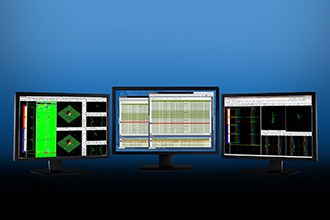Eddy Current Analysis Software: A Critical Component of Your NDT Strategy

Improvements in eddy current probe technology—bobbin, rotating, or array—used in a variety of steam generator and heat exchanger inspections allow technicians to generate ever greater volumes of data and provide more detailed insight regarding the conditions of the object being inspected. However, this increasing wealth of data can quickly become overwhelming when it comes time for analysis. Correct and consistent analysis of eddy current inspection data requires the skill and time of an experienced analyst who often can become the bottleneck in the inspection process as inspection volume and/or frequencies increase.
Automated Eddy Current Analysis Software Streamlines Inspections
Powerful, automated eddy current analysis software allows any enterprise that depends on eddy current inspections for safe, efficient operations to complete those inspections with greater efficiency, accuracy, and consistency. Eddy current analysis software doesn’t replace the need for a skilled analyst. It provides a set of powerful analytic algorithms, the ability to compare current inspection results with historical data, and standardized (yet customizable) reports to minimize human errors or variations in data interpretation.
Eddy Current Analysis Software: Efficiency
Inspection efficiency begins with the ability to create custom configurations for the various inspection methods frequently used. Specify the probe technologies—bobbin, rotating coils, or array—and the analysis methodologies required for the specific inspections and save the configuration for immediate recall when initiating an inspection. Configurations specify inspection parameters such as the flaw types you expect to encounter during a particular inspection, defect classifications, noise monitoring, and historical data comparisons. Configurations reduce setup time, making vital inspection parameters immediately available to the inspection device, allowing the inspector to quickly begin the inspection.
The advanced capabilities of the inspection device allow it to easily handle high-volume probe data acquisition, providing real-time feedback and detailed quantitative and visual results that can be reviewed by the analyst to determine if any repair or mitigation steps need to be taken.
Eddy Current Analysis Software: Accuracy
The power of high-quality eddy current analysis software lies in the sophistication and range of industry-proven detection and classification algorithms. Multiple path analysis, rule-based logic, and the ability to determine the sequence in which algorithms are applied allow analysts to fine-tune the process to achieve the greatest accuracy in detecting flaws.
Analytic software excels in providing real-time results regarding flaw detection and classification, but an even greater benefit may be the comparison of historical eddy current inspection data. Historical results can automatically be loaded and compared with current inspection data to assess changing material conditions or degradation over time to determine if any mitigation is required. The software can also provide a detailed visualization of the extent of any indications to confidently identify any possible defects, their exact location, and characteristics.
Eddy Current Analysis Software: Consistency
Frequent inspections, high volumes of data, and multiple analysts with varying levels of skill and experience are all factors which can contribute to inconsistent interpretation of inspection data during reviews. Comparing the results of recent inspections with historical inspections provides greater confidence in accurately assessing the extent of equipment degradation. Missed or incorrectly classified degradation can lead to unplanned downtime.
Eddy current analysis software supports consistent reporting and interpretation of inspection data in the following ways:
- Applying configured, standardized inspection parameters for specific inspection methods.
- Utilizing a powerful set of algorithms to uncover the type, location, and characteristics of flaws and defects.
- Generating detailed, standardized (as well as customized) reports that visualize and record inspection results.
- Using the same inspection configurations to capture data and generate reports that can be compared over time.
- Giving the user control over the disposition of reported indications using filters such as thresholds, merge types, overlap, and history.
Standard configurations ensure the correct parameters and algorithms are consistently used for specific inspections. Powerful algorithms accurately uncover defects and their characteristics. Historical comparisons allow inspectors to correctly interpret developing problems.
Eddy Current Analysis Software: Use Case
One of the largest power producers in the United States operates numerous steam generators and heat exchangers with more than 500,000 tubes. Inspection data analysis for the balance-of-plant (BOP) systems had always been a manual process with a team of analysts reviewing the data and comparing results from inspection to inspection. Interpretation of flaws and historical data could vary according to the analyst’s skill and experience.
Looking for a consistent, repeatable way to assess and compare eddy current data obtained from tube inspections, the producer adopted new, cutting-edge analysis software to properly interpret flaws indicated by the data, and confidently make the correct decision about whether to plug or repair a tube. The software can take data from a previous inspection, overlay it on top of current inspection data or any other data set, and then highlight any differences in the two data streams. The ability to easily compare data from one outage to another, without the variations and inconsistencies associated with manual analysis, greatly increases confidence regarding changes in flaws or defects over time.
Summary
Efficiency, accuracy, and consistency are requisites for energy producers charged with a frequent or high-volume steam generator and heat exchanger tube inspections. Time-consuming manual analyses are being replaced by automated analysis in a primary, secondary, or single-pass inspection configurations using bobbin, rotating, and array techniques. Automated eddy current analysis reduces inspection time, allowing analysts to classify flaws and defects in considerably less time.
Zetec has been a trusted name in nondestructive inspections for decades and has become the clear leader in eddy current analysis software. To learn how the software can improve inspection efficiency, accuracy, and consistency contact Zetec today.

Zetec’s designers are industry-leading experts in ultrasonic and eddy current technologies, and we can help you navigate any of our NDT testing solutions or devices.
